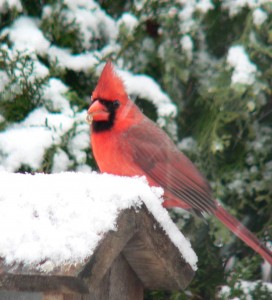
The most frequent bird to be used on North American Holiday Greeting Cards, I suspect, is the Northern Cardinal (Cardinalis cardinalis). Add some snow to the picture of a male cardinal and you have a thing of beauty. This month’s picture, illustrating such beauty, is sent as a Holiday Greeting to you, but you will have to look on the website (OKC-Audubon.org) to see it in color. I want to thank Pat Velte for taking and providing this month’s photo illustrating the Northern Cardinal. Pat is the one who always rounds up “Bird of the Month” photos. She never fails to come up with amazing, beautiful pictures.
The Northern Cardinal is one of the 3 Cardinalis species of the Americas: The Northern Cardinal of the eastern U.S. and much of Mexico, the Vermilion (or Brazilian) Cardinal (C. phoeniceus) of northern South America, and the Pyrrhuloxia (Desert Cardinal) (C. sinuatus) of the deserts in the southwestern U. S. and northern Mexico. Cardinalis species are only found in the New World, so these 3 are it.
Male Northern Cardinals are a striking red and females are brown with red on the crest, wings and tail. Cardinals have very thick, strong bills that almost any bird bander quickly learns about—they bite really hard with these bills. They are a common permanent resident over most of Oklahoma, except in the Oklahoma Panhandle where they become rarer and rarer as you go west; there are a (very) few records of the related Pyrrhuloxia in Cimarron County.
Generally speaking, the Northern Cardinal is found over most of the eastern U.S. and well into the southwestern states; the fact that they are the state bird of 7 states attests to its popularity. They, and the Vermilion Cardinal, have been introduced (unfortunately, according to Warren Harden) onto several of the Hawaiian Islands.
In our yards, they come readily to feeders. Like many other small birds they love black oil sunflower seeds and really flock in when the weather is foul—snow and ice storms. Thus we sometimes get to see them with a backdrop of snow, even if we don’t get them photographed as Pat has.
The Northern Cardinal has done extremely well in the presence of man. Early in the spring they begin courtship; both male and female sing, something of a rarity among birds. Nests are often placed in honeysuckle vines and other thick vegetation and shrubbery around our homes. The female lays 2-5 eggs, but usually 3 or 4, in a nest that averages about 6 feet high. They are a common victim—likely the most common victim in our area—of cowbird nest parasitism. Because cardinals nest multiple times in the spring and summer, they often raise cowbird young in their early nestings. I suspect that most successfully reared young cardinals are raised in cardinal nests in the latter part of the nesting season, after cowbirds are through laying eggs. Thus cardinals replenish more than 1 species—their own and the cowbirds.’
One of my favorite bird stories involves the cardinal and is a true story. A young daughter once asked her father what bird she was seeing outside. He said, “I think it’s a female cardinal, but why don’t you go ask your mother.” The youngster returned somewhat dejected and reported to her father, “You say it’s a female cardinal, but mom says it’s a mama redbird.”
I hope everyone has a wonderful time during the holidays!
